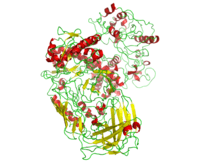Polymerase
A polymerase is an enzyme (EC 2.7.7.6/7/19/48/49) that synthesizes long chains of polymers or nucleic acids. DNA polymerase and RNA polymerase are used to assemble DNA and RNA molecules, respectively, by copying a DNA template strand using base-pairing interactions or RNA by half ladder replication.

A DNA polymerase from the thermophilic bacterium, Thermus aquaticus (Taq) (PDB 1BGX, EC 2.7.7.7) is used in the polymerase chain reaction, an important technique of molecular biology.
A polymerase may be template dependent or template independent. Poly-A-polymerase is an example of template independent polymerase. Terminal deoxynucleotidyl transferase also known to have template independent and template dependent activities.
Types
- DNA polymerase
- Family A: DNA polymerase I; Pol γ, θ, ν
- Family B: DNA polymerase II; Pol α, δ, ε, ζ
- Family C: DNA polymerase III holoenzyme
- Family X: DNA polymerase IV (DinB) – SOS repair polymerase; Pol β, λ, μ
- Terminal deoxynucleotidyl transferase (TDT), which lends diversity to antibody heavy chains.[1]
- Family Y: DNA polymerase V (UmuD'2C) - SOS repair polymerase; Pol η, ι, κ
- Reverse transcriptase, an enzyme used by RNA retroviruses like HIV, which is used to create a complementary strand to the preexisting strand of viral RNA before it can be integrated into the DNA of the host cell. It is also a major target for antiviral drugs.
- RNA polymerase
- Multi-subunit, DNA-directed: RNA polymerase I, RNA polymerase II, RNA polymerase III
- Single-subunit, DNA-directed: T7 RNA polymerase, POLRMT
- RNA replicase
- Primase, PrimPol
In general, viral single-subunit RNA polymerases/replicases/reverse transcriptase shares a common origin with DNA polymerase. They have a conserved "palm" domain.[2] Multi-subunit RNA polymerase forms an unrelated group.[3] Primases have a more complex story: bacterial primases with the Toprim domain are related to topoisomerase and mitochrondrial helicase,[4] while archaea and eukaryotic primases form an unrelated family, possibly related to the polymerase palm. Both families nevertheless associate to the same bunch of helicases.[5]
| DNA-polymerase | RNA-polymerase | |
|---|---|---|
| Template is DNA | DNA dependent DNA-polymerase or common DNA polymerases |
DNA dependent RNA-polymerase or common RNA polymerases |
| Template is RNA | RNA dependent DNA polymerase or Reverse transcriptase |
RNA dependent RNA polymerase or RdRp or RNA-replicase |
See Also
- Central dogma of molecular biology
- Exonuclease
- Ligase
- Nuclease
- PCR
- PARP
- Reverse transcription polymerase chain reaction
- RNA ligase (ATP)
References
- Loc'h, Jérôme (2016). "Structural Basis for a New Templated Activity by Terminal Deoxynucleotidyl Transferase: Implications for V(D)J Recombination". Structure. 24 (9): 1452–1463. doi:10.1016/j.str.2016.06.014. PMID 27499438.
- Hansen JL, Long AM, Schultz SC (August 1997). "Structure of the RNA-dependent RNA polymerase of poliovirus". Structure. 5 (8): 1109–22. doi:10.1016/S0969-2126(97)00261-X. PMID 9309225.
- Cramer, P (February 2002). "Multisubunit RNA polymerases". Current Opinion in Structural Biology. 12 (1): 89–97. doi:10.1016/S0959-440X(02)00294-4. PMID 11839495.
- Aravind, L; Leipe, DD; Koonin, EV (15 September 1998). "Toprim--a conserved catalytic domain in type IA and II topoisomerases, DnaG-type primases, OLD family nucleases and RecR proteins". Nucleic Acids Research. 26 (18): 4205–13. doi:10.1093/nar/26.18.4205. PMC 147817. PMID 9722641.
- Iyer, LM; Koonin, EV; Leipe, DD; Aravind, L (2005). "Origin and evolution of the archaeo-eukaryotic primase superfamily and related palm-domain proteins: structural insights and new members". Nucleic Acids Research. 33 (12): 3875–96. doi:10.1093/nar/gki702. PMC 1176014. PMID 16027112.